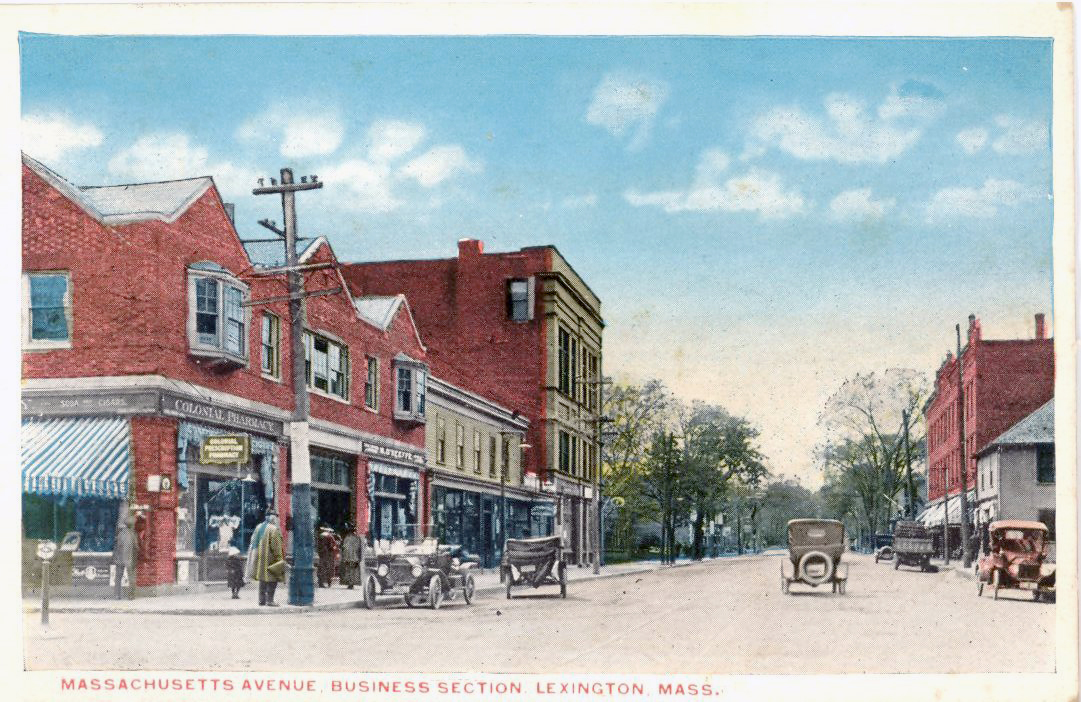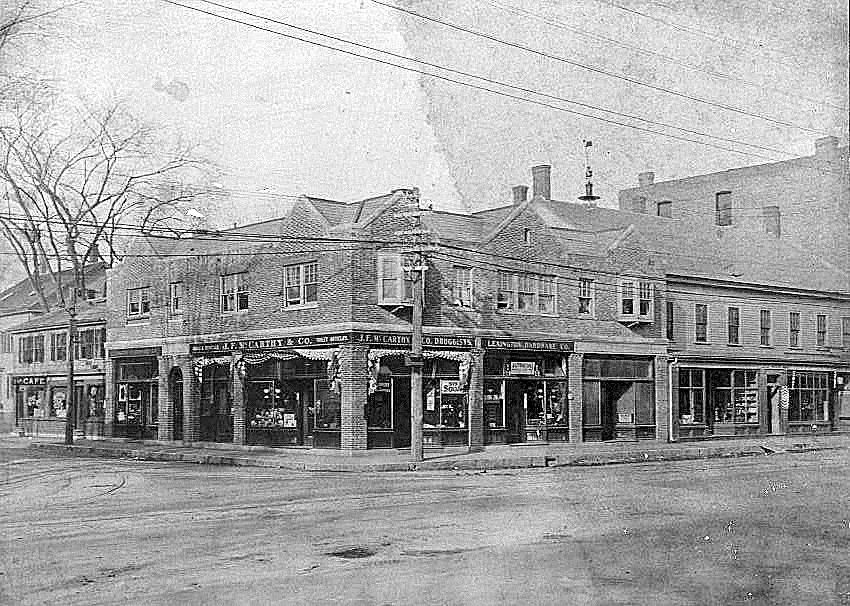The Center
L E A R N A B O U T L E X I N G T O N

O nce upon a time, Lexington center was bustling with many different stores, from blacksmiths to kalsominers. (I had to look this one up. Calcimine was an easy coating to give interior surfaces and clean look. If you have it on your walls and ceilings, you already know that other paints do not adhere well.) In those days, a resident could go to town between Meriam and Waltham streets, buy aspirin at Colonial Pharmacy, get some shoes at Michelson’s, repair a bike, go to the dentist and shoe his horse at E. B. MacLalan’s Blacksmith Shop. Lothrop’s Lexington, Massachusetts Blue Book and Directory indicates that there were ten food stores specializing in different foods. One even had clams and oysters!
Lexington center has undoubtedly changed. Today, it has ten banks between Meriam and Waltham streets; in those days, there were only three.
The Early Days
First settled in 1642 as a farming community that was part of Cambridge, Lexington became incorporated as a separate town in 1713. After the Revolutionary War, the town was still a farming community, with two small mills, a few stores, some fur factories in East Lexington, and several blacksmith shops and public houses. The Simonds Tavern at 331 Bedford Street and Bowman Tavern at 837 Massachusetts Avenue still exist but as private residences.
In 1846, the railroad came to town. Initially, the train ran three times a day between Lexington and Boston, and Lexington began to thrive. Thinking about all the wealth that the railroad would bring, Benjamin Muzzey demolished his old hotel and built a larger one on the same Massachusetts Avenue site opposite Waltham Street (the present site of CVS) for $20K. It became a popular spot for public functions and dances; it had a barn, bowling alley, and billiard.
Lexington’s population began to grow more rapidly with easy access to Boston. Escaping from the potato famine, Irish immigrants moved to town and worked for the railroad, labored on farms, or undertook domestic work. Many professionals seeking fresh air and land moved from Boston and constructed stately houses on Bloomfield Street and on Meriam Hill and Munroe Hill.
In 1875, as 2,277 Lexingtonians prepared to celebrate the 100th anniversary of the Battle on the Green, a letter to the relatively new Lexington Minuteman pointed out that the area in front of the railroad depot was most unattractive: “a deplorable mess of railroad ties, coal bins, and piles of wood right in Lexington Center.” The Common was used for growing hay, which was sold by the selectmen to the highest bidder.
In 1876, the Lexington Field & Garden Club was organized to improve the appearance of the depot area and open spaces. By 1887, the Club announced that it was willing to care for the Common on the condition that the town provided $150/year while the Club gave $50/year. Under its authority, the hay-covered Common, once filled with grazing cows, became a beautiful park.
In 1870, the paint mine off Grove Street, with its natural ochre that produced yellow-brown pigment, was incorporated as the Lexington & Boston Paint Company. Matthew Merriam, whose primary business was leatherwork for boots and shoes, located his factory at 7-9 Oakland Street in 1882. Later known as “the Father of the American Gear Cutting Industry,” George Grant opened a gear works near the end of Fletcher Avenue in 1888. Muzzey & Whitcher’s Grain Mill was built behind what is now 1775 Massachusetts Avenue in 1884.
Between 1870 and 1915, Lexington’s population more than doubled — from 2,270 to 5,538. The improved access offered by the railroad transformed the rural town into a railroad suburb: by 1900, 11 trains ran daily each way between Lexington and Boston, and by 1904, there were five station stops in town. In April 1900, the Lexington and Boston Street Railway system opened and soon offered service to Woburn and Waltham, and Boston. In 1901 the Street Railway Company developed “Lexington Park” (across from Westview Cemetery). This multipurpose amusement facility included a theater, casino, dining pavilion, shooting gallery, roller skating rink, library, observation tower, women’s building, and zoo animals.
The 20th Century
With the dawn of the 20th Century, the town’s central business district began to expand. In July 1906, Cary Memorial Library opened on its existing site; before that, it had operated in two rooms over a store. Local architect Willard D. Brown designed the Hunt Block at 1752 Massachusetts Avenue (corner of Waltham Street). In 1906, Nellie and Thomas Breslin built the “Stone Store” at 2219 Massachusetts Avenue.
Appreciating its history, the town purchased Buckman Tavern in 1913. The 46-year-old Lexington Historical Society contributed $12,000 of the $42,000 sales price. The Town of Lexington then leased it back to the Lexington Historical Society to operate as a historic house museum.

As the town grew, the houses and barns that had lined the streets were demolished and converted into commercial space. The classical Revival-style Theatre Block at 1792-1804 Massachusetts Avenue was erected in 1916. With five small stores, the Ribock Block (now Michelson’s/Theatre Pharmacy) was built at 1780 Mass. Ave. in 1921.
The nation’s economy grew at an average of 7% a year between 1922 and 1927, and the nation’s wealth soared to $103 billion in 1929. According to the Lexington 1924 Directory: four stores sold hardware, four were barbershops, five were boot and shoe dealers (one being Michelson’s), and two were taxi services (one included a livery and boarding stable). There were also two horseshoers and five boarding and lodging houses. And, of course, there were those ten food stores.
Despite the thriving commercial activity, there were only three banks. The oldest was Lexington Savings Bank, which opened in 1871 to help the post-Civil War economy. Constructed around 1904, the building initially housed the bank on the second floor and a Post Office and a store on the first floor.
In the early 1920s, the Center went from Meriam to Waltham Street – about 700 feet. By 1928, it expanded past Waltham Street. In 1927, the colonial revival-style Isaac Harris Cary Memorial Hall and the Lexington Town Office Building were constructed on Massachusetts Ave. In the late 1920s, First National Grocery Stores opened on 450 Mass Ave, and Gray EE Co. expanded from an individual grocery store to a chain business. By this time, hairdressers and beauty salons had moved into the area, although most Lexington residents still shopped in Boston for clothing.
Of course, the 20s were followed by the Depression and World War II. With the end of the war came Route 128—the “Great Circumferential,” and the beginning of many changes for Lexington.
* Thanks to some hard-working research librarians, we found that Massachusetts Ave was renumbered in 1929. They wondered if it had to do with the town purchasing land in the Center (the “Central Block”) from the Middlesex and Boston Street Railway Company for the Public Works department.
